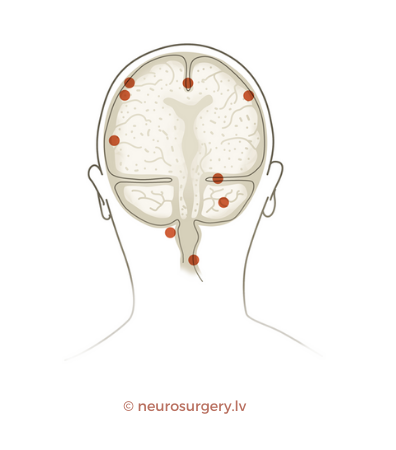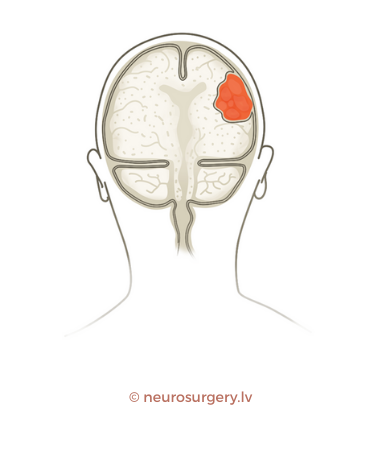Conditions
Meningioma
What is Meningioma?
Meningioma is one of the most common (the most frequent benign or relatively benign) intracranial (skull) and spinal canal tumors. It originates from the arachnoid membrane (Latin: arachnoidea), which covers the brain and spinal cord. The arachnoid membrane is one of the three protective layers surrounding the brain.
Thus, a meningioma is not a brain tumor itself but a tumor of the brain coverings that can press into the brain. Most meningiomas are benign tumors that can be completely cured with surgery, but rare cases may be malignant.

Where Can Meningiomas Form?
Meningiomas can develop in virtually any location within the skull or spinal canal where meningeal tissue is present. In some cases, multiple meningiomas may form in a single patient. Rare meningioma locations include the optic nerve sheath and the ventricular system of the brain.

Symptoms of Meningioma
Since meningiomas typically grow very slowly, they often remain asymptomatic until they reach a significant size and start compressing the brain or nerves.
Common symptoms of meningiomas in the brain include:
- Progressive headaches
- Rarely: new-onset seizures (epileptic episodes)
- Neurological deficits (weakness on one side of the body, difficulty speaking, loss of smell, etc.)
- Behavioral changes, confusion, or drowsiness
Symptoms depend on the specific tumor location within the skull. Due to gradual, slow progression, these symptoms are often misattributed to aging.
Spinal meningioma symptoms include:
- Movement and sensory impairments in the limbs.
How Common Are These Tumors?
Meningiomas account for 34% of primary intracranial tumors. They are most often diagnosed between ages 30–70, with 2–3% being malignant.
Meningiomas occur twice as often in women as in men. Spinal meningiomas are 10 times more common in women.
How Is Meningioma Diagnosed?
The primary diagnostic method is magnetic resonance imaging (MRI). Due to increasing use of imaging studies (brain and spine MRI/CT scans), many meningiomas are found incidentally when patients undergo scans for unrelated reasons.
What Should You Do If Diagnosed with Meningioma?
Modern MRI scans allow radiologists to reliably determine whether a tumor is a meningioma. If an MRI report confirms a meningioma, a neurosurgical consultation is necessary to evaluate treatment options.
Meningioma does not always require urgent surgery. Often, incidental meningiomas are small and asymptomatic, allowing for active surveillance, with yearly MRI scans to monitor growth.
If a meningioma causes health issues or shows evidence of growth, surgery may be considered. During a consultation, a doctor will explain the advantages and risks of different treatment approaches.
If you or a loved one has confirmed or suspected meningioma, a neurosurgical consultation is recommended.
We offer in-person and remote consultations via video calls. Appointments can be scheduled online, via phone, or email. Contact us to arrange a remote consultation.
What Does Surgery for Meningioma Involve?
Surgery is performed under general anesthesia, aiming for maximum tumor removal while ensuring safety.
The surgical approach depends on the tumor's location, its relationship with surrounding structures, and the surgeon's expertise in meningioma removal.
Since 1957, Simpson's classification of five levels of meningioma removal has remained relevant, guiding how surgical radicality impacts recurrence risk. Whenever possible, the tumor should be removed entirely, along with affected dura and surrounding structures, followed by repair of the dura and bone defects.
If you are considering surgery with us, you can read patient testimonials from both Latvian and international patients.
Our surgical facility, where procedures and interventions take place, is the modern, well-equipped Aiwa Clinic.
Preparing for surgery often brings many questions—learn more about frequently asked questions regarding meningioma surgery.
Post-Surgical Follow-Up
Although meningiomas are mostly benign, even complete removal carries a recurrence risk of 8.5% over 10 years. In less radical procedures, the recurrence rate jumps to 18.8% over the same period.
Follow-up care includes:
- Regular MRI scans for life
- First MRI follow-up at 6–12 months post-surgery
- Subsequent scans every 1–3 years